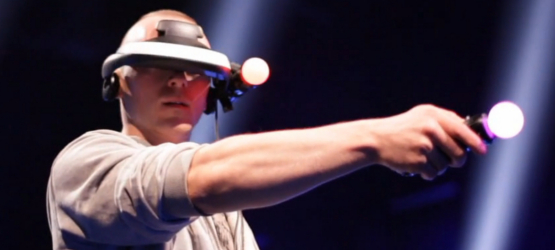Daily Reaction is a PSLS exclusive feature where Sebastian Moss & Dan Oravasaari discuss today’s most hard-hitting topics every single weekday.
This time on Daily Reaction we talk Virtual Reality headsets – with the John Carmack-endorsed VR device Oculus Rift making a huge splash on Kickstarter, Sony patenting VR glasses and releasing a 3D headset, Google bringing out Google Glasses and a rumored leaked Microsoft document showing ‘Fortaleza’ glasses for the next Xbox, it seems everybody is interested in putting technology on your face. But could it be a big deal in the next generation of gaming?
Seb: The idea of a Virtual Reality headset is awesome – it’s far more immersive than any TV could ever be, regardless of whether it’s 3D enabled or very, very large. Potentially, you could see exactly what you could see if you were in the game. Potentially.
Just like 3D could potentially make everything have way more depth and look way better, or wearing full rumble clothes could potentially make everything more realistic, there’s a strong chance that VR could end up being another great idea that isn’t adopted by enough people to give it strong developer support. 3D showed people a) don’t like spending a lot of money for a visual improvement and b) don’t like wearing some bulky glasses (and the Oculus Rift is very bulky). Not to mention all the issues of whether people already have glasses or if the product gives you headaches.
But 3D was really pushed by manufacturers and movie makers, it wasn’t in response to demand. It was a reason for people to go to cinema and pay more, and a reason to upgrade your HDTV. So it wasn’t a huge surprise when it never kicked off in a big way.
VR, on the other hand, has been the dream of many a techie and so could find more success. Oculus Rift is interesting, but it only has a few thousand backers at the moment. Google Glasses, on the other hand, has the might of the big G behind it – the guys that made the 900k a day selling Android platform, and own the world’s largest search engine, among other things. So they’re going to take Google Glasses, link them up with Android, make them sexy and make them popular.
Looking forward to a VR future? Don’t worry, it won’t be long.
Dan: It is undeniable that VR is the long term goal for many interactive mediums, as we have seen it portrayed in movies, and television shows, and hoped to experience that one day. The answer that most developers have come up with is the VR headset, a way to saturate a person’s senses while closing off as many outside distractions as possible. A great idea in itself, as I have tried a few over the years, and they were entertaining experiences. Yet they required a number of accessories and sensors to fully encompass the desired effect. This leads me into the biggest, yet simple problem that develops seem to miss. Most people who are trying to relax with a piece of media, are very unlikely to go through numerous steps to relax.
Much like the problem 3D is seeing in low attachment rates, consumers do not want to set up their glasses, and wear them while watching a movie or playing a game. Asking a consumer to put on some extremely geeky headset, is going to be a difficult sell until it becomes common place, and the only way for that to happen would be for an external market to force interaction with the product. Namely, the movie industry would need to move theaters into VR cafes, so that people would just see VR as a semi-replacement for the television. Even still, the isolationism that occurs by cutting off everyone around you, would completely negate any social attributes given to playing games or watching movies with others. Again, we see a problem where the technology takes one step forward, but two back.
Seb: I see where you’re going with the whole anti-social aspect of VR, but that’s only with the big, bulky headsets. Just like phones used to be bigger than your head, stuff shrinks. Google Glasses are tiny, and they are more augmented reality than full, closed off immersion. That’s where I see VR going. Take a look at the rumored leaked Microsoft document, which has since been backed by numerous independent sources:

It was under their Kinect segment, it’s meant to revolutionize the living room. It isn’t a basement dweller’s product, it’s a ‘family friendly’ device. At this stage, I’m not worried about whether VR headsets will have a big impact on gaming, I’m hoping that the impact isn’t just like Kinect and Wiimote – a great idea ruined by a push for casual gold, but something that can also massively impact the immersion of core game – especially on portable devices like the Vita.
Dan: I agree the ‘Fortaleza’ is an interesting idea, and it addresses the issues I brought up earlier, but it is as you stated – it’s augmented reality and not full VR. So in the sense that we are able to maintain a potentially semi-VR experience, while having some semblance of social behavior, ‘Fortaleza’ could be the way to go. Although, I would have to see it to believe it, as the technology sounds interesting, the actual execution of it is what really matters. We are yet to truly know just how well the glasses could implant a virtual object in a dynamic environment that changes from person to person. Is it going to require something similar to the VR cards that came with the Vita? Something that was an interesting idea, but ultimately is a clunky experience. So, while I can imagine technology behind the product working, I have a feeling that it’s going to end up more virtual than reality. So until we see something more concrete from Microsoft, I still think Google will have the the best chance to bring VR to market with Google Glass, as their approach is already set to have a limited release in the near future.








